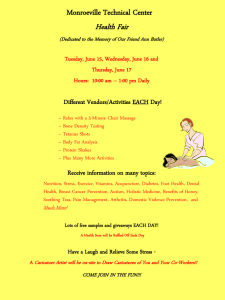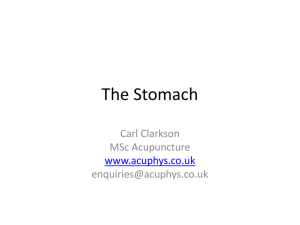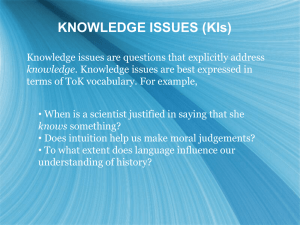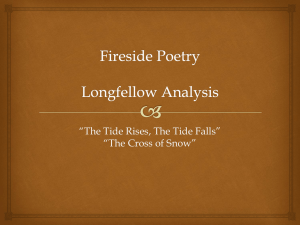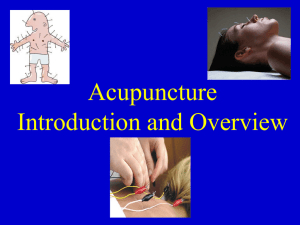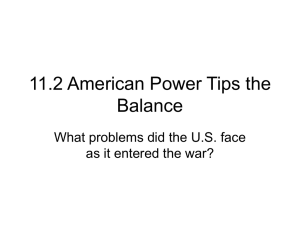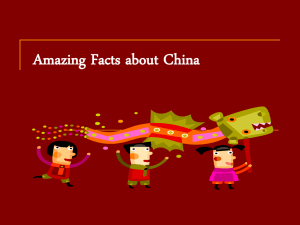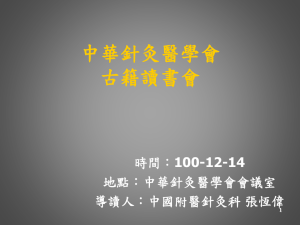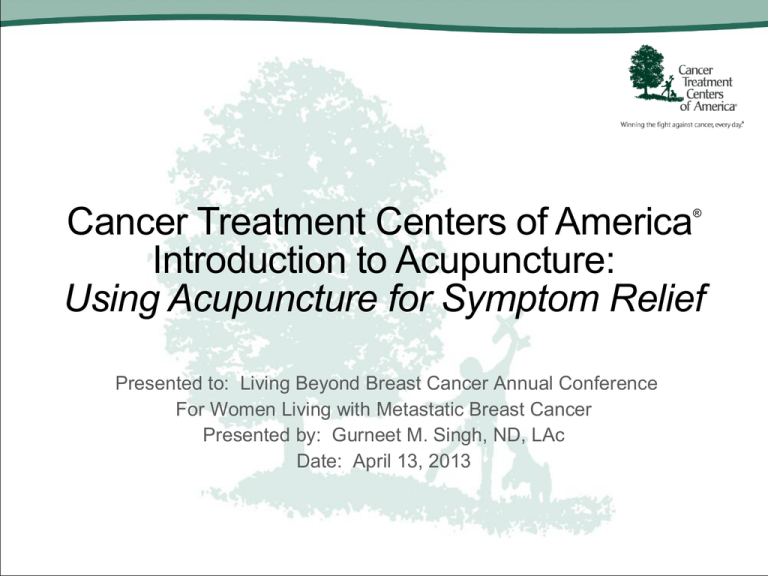
Cancer Treatment Centers of America
Introduction to Acupuncture:
Using Acupuncture for Symptom Relief
®
Presented to: Living Beyond Breast Cancer Annual Conference
For Women Living with Metastatic Breast Cancer
Presented by: Gurneet M. Singh, ND, LAc
Date: April 13, 2013
Overview of Presentation
●
●
●
●
●
●
●
●
●
Introduction
Philosophy & How Acupuncture Works
Benefits of Acupuncture
Uses of Acupuncture & Acupuncture’s Role in
Breast Cancer Care
Safety, Precautions and Risks
Treatment: Practical Information
Finding Qualified Licensed Acupuncturists
Conclusion
Questions and Answers
2
© 2012 Rising Tide
INTRODUCTION
3
© 2012 Rising Tide
Introduction: Acupuncture
• Acupuncture originated in China over 2,000
years ago.
• One of the oldest and most commonly used
medical practices in the world.
• Essential part of Traditional Chinese Medicine.
• Takes a more “energetic” approach to
pathology, diagnosis, and treatment.
4
© 2011 Rising Tide
Philosophy: Understanding Acupuncture
and How it Works
Chinese Medical Theory and Western Medical/Scientific Understanding
5
© 2012 Rising Tide
Philosophy: Chinese Medical Theory
• Definition: Acupuncture is an ancient medical
practice, which involves the gentle insertion of
needles to stimulate specific therapeutic points
on the body. This is thought to encourage the
flow of energy within the body, therefore
restoring harmony and balance to the body.
• Basic art of acupuncture: BALANCE!
• Balance is the center pillar from which all
understanding, diagnosis, and treatment is
made.
6
© 2011 Rising Tide
Yin Yang
7
© 2011 Rising Tide
Yin Yang
YIN
YANG
Contraction
Expansion
Passive/Rest
Activity
Cold
Hot
Internal
External
Quiet
Restless
Female
Male
Darkness
Light
8
© 2011 Rising Tide
Yin Yang
• Ideal wellness equals balance.
• Pathologies and diseases are considered
imbalances.
• Understood that all conditions are evolving and
changing.
• Example: Menopause, common symptoms
include hot flashes, night sweats, heat in the
palms of hands and soles of feet, insomnia,
restlessness.
9
© 2011 Rising Tide
Qi
• Pronounced “chee”
• Simplified and typically defined as Vital Energy
and Life Force.
• Believed to regulate a person’s spiritual,
emotional, mental and physical balance.
• Influenced by opposing forces of yin and yang.
10
© 2011 Rising Tide
Qi
• Components/types of Qi:
– Congenital Qi equals the energy the individual is born
with, plus genetic predisposition.
– Acquired Qi: including Food (Gu Qi) and Air (Kong
Qi).
– Thus, we are born with certain genetic dispositions,
while the food we eat and air we breathe will help to
determine our state of health.
• Born with excess amounts of qi; as we age, this
level of qi decreases naturally.
11
© 2011 Rising Tide
Meridians
• Almost 400 acupuncture points, which line up
into what we call meridians or channels.
• Qi travels through the body in these meridians or
channels.
• Meridians conduct energy between the surface
of the body and internal organs.
• Meridians run in regular patterns through the
body and over its surface.
• Like rivers flowing through the body to irrigate
and nourish the body.
12
© 2011 Rising Tide
Meridians
13
© 2011 Rising Tide
Meridians
• In an ideal, healthy state, qi is flowing smoothly
and freely within the body.
• When there is an internal imbalance of qi and
yin/yang in the body, this will lead to an
obstruction to the flow of qi in the meridians.
• Then pain, disease, and dysfunction will result.
14
© 2011 Rising Tide
Meridians
• An acupuncturist seeks to restore balance to the
flow of qi by gently stimulating these specific
therapeutic points on the body assisting in
removing any “dams” or stagnation.
• The encouragement of the smooth flow of qi is
thought to result in the relief of symptoms and
the promotion of health.
15
© 2011 Rising Tide
Western Medical Perspective &
Theories on Mechanisms of Action
• There are no existing entities in Western
medicine which directly relate to qi, meridians, or
acupuncture points.
• Examines physiological changes.
• Stimulates and releases natural neurochemicals
in the body, endorphins and enkephalins. These
are natural painkillers and anti-inflammatories.
• Studies have shown increases in serum and
cerebrospinal fluid levels of endorphins and
enkephalins after acupuncture.
16
© 2011 Rising Tide
Western Medical Perspective &
Theories on Mechanisms of Action
• Immune enhancing: transient increases in white
blood cells, antibodies, immunoglobulins, natural
killer cell activity.
• Decreases histamine response, thus decreasing
the anti-inflammatory response.
• Encourages release of other neurotransmitters
and neurohormones, such as serotonin.
• Balances the central and peripheral nervous
systems by regulating blood pressure, affecting
blood circulation and body temperature.
17
© 2011 Rising Tide
Western Medical Perspective &
Theories on Mechanisms of Action
• Enables electromagnetic signals to be relayed at
a greater rate, so it may affect motor nerve firing.
• Electrical impedance of the skin is lower at
acupuncture points, these correlate with where
cutaneous nerve beds exist. (involved in
analgesic affect of acupuncture)
• Gate theory of pain transmission in the spinal
cord: with competing sensory information from
acupuncture, will prevent/block pain fibers from
transmitting pain signals.
18
© 2011 Rising Tide
Benefits of Using Acupuncture
Why consider using acupuncture?
19
© 2012 Rising Tide
Benefits
• Minimal concern of negative side effects or risks.
• Incidence of adverse reactions is very rare.
• Minimal concern of interference with other
medications or treatments.
• Often symptom relieving pharmaceuticals can
also produce side effects.
• Some patients may not want to take more
medications (and again concern of interactions).
20
© 2011 Rising Tide
Benefits
• Some patients may have intractable issues that
are not responding to conventional methods.
• Multiple issues can be addressed with each
treatment.
• Can be performed in any setting, as long as the
patient is comfortable. (No special equipment is
needed; very transportable.)
• Side effects are often beneficial…increase in
energy, digestive support, decrease stress,
better mood, improved sleep.
21
© 2011 Rising Tide
Uses of Acupuncture
What can acupuncture be used to treat?
22
© 2012 Rising Tide
Indications for Acupuncture
• Acupuncture is often associated with
musculoskeletal injuries and pain control, but it
actually has very broad applications, including:
-gynecological disorders
-respiratory disorders
-gastrointestinal problems
-neurological disorders
-dermatological problems
-mood/emotional issues
23
© 2011 Rising Tide
Acupuncture in Oncology
• Can be integrated and utilized alongside
conventional treatments, such as chemotherapy
and radiation (without negative interactions).
• Research on the use of acupuncture as a
complement to conventional cancer treatment.
• Not used to cure or treat cancer.
• Used to reduce side effects of chemotherapy,
radiation, surgery and medications.
• Improves and supports quality of life.
24
© 2011 Rising Tide
Acupuncture in Breast Cancer Care
•
•
•
•
Pain management
Surgery preparation and recovery
Affect peripheral neuropathies
Improve digestive function: decrease
nausea/vomiting, promote appetite, decrease
constipation/diarrhea
• Encourage circulation
• Decrease hot flashes and menopausal
symptoms
25
© 2011 Rising Tide
Acupuncture in Breast Cancer Care
• Support immune function
• Increase range of motion and decrease
discomfort, tightness, and heaviness associated
with lymphedema
• Decrease fatigue
• Decrease insomnia
• Decrease xerostomia (dry mouth)
• Assist in addiction recovery, including smoking
cessation
26
© 2011 Rising Tide
Acupuncture in Breast Cancer Care
•
•
•
•
Decrease dyspnea (shortness of breath)
Alleviate stress and promote relaxation
Reduce feelings of anxiety and depression
Restore an overall sense of well-being and
promote a sense of balance
27
© 2011 Rising Tide
Research-Breast Cancer
: Walker, E., et al. (2010). Acupuncture
Versus Venlafaxine for the Management of Vasomotor Symptoms in Patients With Hormone ReceptorPositive Breast Cancer: A Randomized Controlled Trial. Journal of Clinical Oncology, 28(4), 634-640.
• Hot flashes: Adverse effect of anti-estrogen
hormone treatment in breast cancer care.
– Randomized controlled trial to test whether
acupuncture reduces vasomotor symptoms and
produces fewer adverse side effects in patients with
Hormone Receptor Positive Breast cancer compared
to Effexor (venlafaxine).
– 50 patients were randomly assigned to either receive
12 weeks of acupuncture or Effexor.
– Both groups had significant decreases in hot flashes
and depressive symptoms, improvement in mental
health.
28
© 2011 Rising Tide
Research-Breast Cancer
: Walker, E., et al. (2010). Acupuncture
Versus Venlafaxine for the Management of Vasomotor Symptoms in Patients With Hormone ReceptorPositive Breast Cancer: A Randomized Controlled Trial. Journal of Clinical Oncology, 28(4), 634-640.
– Changes were similar indicating that acupuncture was
as effective as Effexor.
– However, after 2 weeks post-treatment, the Effexor
group experienced significant increases in hot
flashes, while in the acupuncture group hot flashes
were still managed at low levels.
– Additionally, Effexor group experienced 18 incidences
of adverse effects (nausea, dry mouth, dizziness,
anxiety), while the acupuncture group experienced 0.
– Acupuncture group also reported improvement in
energy, libido, clarity of thought and sense of well
being.
29
© 2011 Rising Tide
Research-Breast Cancer
Crew, K., et al. (2007). Pilot Study of
Acupuncture For the Treatment of Joint Symptoms Related to Adjuvant Aromatase Inhibitor Therapy in Postmenopausal
Breast Cancer Patients. Cancer Surviv. 1(4):283-291.
• Pain-Joint symptoms related to adjuvant
aromatase inhibitor therapy in post-menopausal
breast cancer patients
– Pilot study, 19 women with early stage breast cancer
with musculoskeletal complaints related to AI therapy.
– Received acupuncture twice weekly for 6 weeks.
– Improvement in pain scores, pain severity, painrelated functional interference.
– Improvement in physical well-being.
– No adverse effects.
30
© 2011 Rising Tide
Research-Breast Cancer
Molassiotis, A. Bardy, J., Finnegan-John, J.,
Mackereth, P., Ryder, D., Filshie, J., Ream, E., Richardson, A. (2012). Acupuncture for Cancer-Related Fatigue in
Patients with Breast Cancer: A Pragmatic Randomized Controlled Trial. Journal of Clinical Oncology, 30(36), 4470-4476
• Acupuncture for Cancer-Related Fatigue in
Patients with Breast Cancer.
– Randomized controlled trial with 2 groups, 227
patients receiving acupuncture and 75 patients
receiving “usual” care (booklet on managing fatigue).
– Acupuncture group received acupuncture treatment
for 20 minutes once per week for 6 weeks.
– Outcome measures using a Multidimensional Fatigue
Inventory, reporting significant improvements in
overall fatigue, physical and mental fatigue, activity,
motivation, psychological distress, and quality of life.
31
© 2011 Rising Tide
Safety
Safety, Risks, Side Effects, Relative Contraindications, Precautions
32
© 2011 Rising Tide
Safety
• FDA approved acupuncture needles for use by
licensed practitioners in 1996.
• FDA requires sterile, nontoxic needles be used
and are labeled for single use.
• Training of acupuncturists in the US
– In addition to the study of Chinese medicine,
students will study Western medicine
(anatomy, physiology, pathology).
33
© 2011 Rising Tide
Risks/Side Effects
• Typically, side effects are positive changes in
sleep, appetite and bowel function, energy and
emotional state.
• On occasion, original symptoms may worsen for
a short period of time, then improve.
• Discomfort, bleeding, or bruising with needle
placement/removal.
• Potential RARE risks: infection, fainting, broken
needles, spontaneous abortion, organ puncture,
pneumothorax, nerve damage.
34
© 2011 Rising Tide
Relative Contraindications
•
•
•
•
Rash, infection, skin affected by radiation
Open wounds
Pacemaker (for electro-acupuncture)
Lymphedema
35
© 2011 Rising Tide
Precautions
•
•
•
•
•
Pregnancy
Blood thinners
Bleeding disorders
Thrombocytopenia (low platelets)
Severe delirium, psychosis, belligerence
36
© 2011 Rising Tide
Treatments
Practical Information!
37
© 2011 Rising Tide
What Should You Expect?
• Settings-hospital (in and out-patient), community
style, private practice, Medical acupuncture
• Initial Consultation-focus on main complaints, in
addition to a thorough, comprehensive history
• Objective measures: Tongue and Pulse
• Treatment time varies: 15 to 45 minutes
38
© 2011 Rising Tide
How should I prepare for treatment?
• Recommended to avoid heavy meals, alcohol,
strenuous and prolonged physical activity both
before and after treatment.
• Usually recommended to take it easy following
treatment, particularly after the first acupuncture
treatment.
39
© 2011 Rising Tide
What are the needles like?
•
•
•
•
Sterile and disposable.
Metallic, extremely thin and flexible.
Comparable to a strand of hair!
Solid, so they are different from the hypodermic
needles used for vaccinations or drawing blood.
• Nothing is being injected into the body.
• Most patients feel NO discomfort or minimal
discomfort, such as a slight pinch or pressure.
• Placed at different angles, superficially.
40
© 2011 Rising Tide
What are the needles like?
• Photo of needle
41
© 2011 Rising Tide
What are the needles like?
• Once needles are placed, you will not feel
discomfort.
• Needle placement is very quick, usually under 5
minutes.
• On average, about 10 to 15 needles.
• Retained in the skin for 15 to 45 minutes.
42
© 2011 Rising Tide
What does the treatment feel like?
• Generally, patients feel extremely relaxed during
the treatment…majority fall asleep!
• May experience “qi sensation” during treatment:
limbs may feel heavy, may feel pressure, ache,
tingling, itching at acupuncture points, may feel
internal movement/circulation.
• After treatment, patient may experience a
decrease in presenting symptoms and will feel
relaxed.
43
© 2011 Rising Tide
How many treatments will I need?
• Frequency of visits depends on the issue being
treated, how acute or chronic it is, the person’s
constitution.
• Generally, once per week for treatments until
lessening of symptoms, then may stagger visits.
• Some people choose to receive acupuncture
after conditions improve, for maintenance and
general well-being.
• Usually, a series of treatments are
recommended, about 5 or 6 treatments.
44
© 2011 Rising Tide
Finding A Licensed Acupuncturist
• Master Degree (3-4 years of study) at a program
accredited by ACAOM (Accreditation Commission for
Acupuncture and Oriental Medicine)
• National certification exam (NCCAOM-National
Certification Commission for Acupuncture and Oriental Medicine)
•
•
•
•
•
Credentials (State Licensed, NCCAOM Diplomate)
www.nccaom.org
www.acupuncturepa.org
www.licensepa.state.pa.us
www.cancercenter.com
45
© 2011 Rising Tide
Conclusion
• Acupuncture is a safe and effective modality that
can be utilized to address numerous issues and
side effects of metastatic breast cancer and it’s
treatments.
• Acupuncture is holistic, natural and balancing in
essence and can cause profound beneficial
effects physically, mentally, and emotionally
when included in the care and treatment of
patients with breast cancer.
46
© 2011 Rising Tide
Question and Answer Session!
47
© 2011 Rising Tide
References/Resources:
• Cohen, A., Menter, A., Hale, A. (2005). Acupuncture:
Role in Comprehensive Cancer Care-A Primer for the
Oncologist and Review of the Literature. Integr Cancer
Ther, 4(2);131-143.
• Crew, K., Capodice, J., Greenlee, H., Apollo, A.,
Jacobson, J., Raptis, G., Blozie, K., Sierra, A.,
Hershman, D. (2007). Pilot Study of Acupuncture For the
Treatment of Joint Symptoms Related to Adjuvant
Aromatase Inhibitor Therapy in Postmenopausal Breast
Cancer Patients. Cancer Surviv., 1(4):283-291.
48
© 2011 Rising Tide
References/Resources:
• Dos Santos, S., Hill, N., Morgan, A., Smith, J., Thai, C.,
Cheifetz, O. (2010). Acupuncture for Treating Common
Side Effects Associated with Breast Cancer Treatment: A
Systemic Review. Medical Acupuncture, 22(2): 81-97.
• Maciocia, G. (1989) The Foundations of Chinese Medicine:
A Comprehensive Text for Acupuncturists and Herbalists.
New York: Churchill Livingstone.
• Molassiotis, A. Bardy, J., Finnegan-John, J., Mackereth, P.,
Ryder, D., Filshie, J., Ream, E., Richardson, A. (2012).
Acupuncture for Cancer-Related Fatigue in Patients with
Breast Cancer: A Pragmatic Randomized Controlled Trial.
Journal of Clinical Oncology, 30(36), 4470-4476.
49
© 2011 Rising Tide
References/Resources:
• Peiwen, L. (2003) Management of Cancer with Chinese
Medicine. China: Donica Publishing Ltd.
• Sagar, S. (2001) Restored Harmony: An Evidence Based
Approach for Integrating Traditional Chinese Medicine into
Complementary Cancer Care. Hamilton, Ontario:
Dreaming DragonFly Communications.
• Walker, E., Rodriguez, A., Kohn, B., Ball, R., Pegg, J.
Pocock, J., Nunez, R., Peterson, E., Jakary, S. & Levine, R.
(2010) Acupuncture Versus Venlafaxine for the
Management of Vasomotor Symptoms in Patients With
Hormone Receptor-Positive Breast Cancer: A Randomized
Controlled Trial. Journal of Clinical Oncology, 28(4), 634640.
50
© 2011 Rising Tide
References/Resources:
• Websites:
• http://nccam.nih.gov/health/acupuncture
• www.medicalacupuncture.org/acu_info/articles/
nccaminfo
• www.collegeofacupuncture.com
• www.healthscout.com
• www.acupuncture.com/newsletters
• www.cancer.org
• www.cancer.gov/cancertopics
51
© 2011 Rising Tide
References/Resources
• http://www.ncbi.nlm.nih.gov/pubmed/14687469
• http://www.ncbi.nlm.nih.gov/pubmed/16548350
• www.educationportal.com/acupuncture_training.html
52
© 2011 Rising Tide

